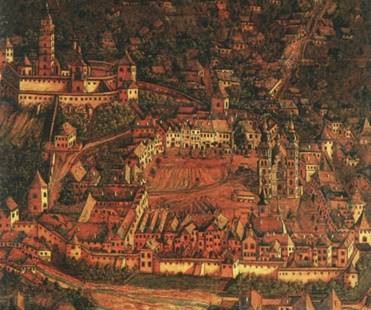
1668-1670. Purple route: A geological odyssey
This picture by Jeremias Roth von Rothenfels (1729) depicts the famous mining town of Kremnica in present day Slovakia. It shows the castle (top left) and mint (bottom left).
On December 8, 1667, the same day that Steensen received the sacrament of confirmation from the papal nuncio, he received a summons from Frederik II, King of Denmark, to return home. Before leaving, Steensen wished to write up the most important of his geological observations, as a mark of gratitude to his patron, Grand Duke Ferdinando II. The resulting work De solido intra solidum, revolutionized geology. In the autumn of 1668, almost a year after the summons, Steensen began his trip to Denmark. He was uncertain as to the reception he would receive as a Catholic in Denmark, and delayed, awaiting notice that he would be allowed to practice his religion, something he never received.
First he travelled south to Rome and Naples, then back to Rome where he spent Christmas. He then went north by way of Loreto, Bologna and Venice to Innsbruck, and stayed three months with Grand Duchess Anna de’Medici, making excursions to the emerald and salt mines in Tyrol. He travelled through many mountainous regions and took advantage of every opportunity to study the mining industry and geological sites of interest. He travelled to Eastern Europe, to the mines in Banská Stiavnica and Kremnica in present day Slovakia. He returned to Vienna, where he decided to abandon the idea of going to Denmark and instead travelled to Amsterdam by way of Prague and Germany.
This return visit to Amsterdam influenced Steensen deeply, and he determined to devote his life to leading others to the Catholic Church. While in the Netherlands he learned that Frederik III of Denmark had died, and that Grand Duke Ferdinando de’Medici was gravely ill. Steensen rushed back to Florence to aid his patron, only to find on his arrival that Ferdinando was already dead.
Steensen travelled over 6.000 km. on this journey without ever reaching his intended destination. Instead, his trip had turned into a grand geological odyssey and resulted in a deep religious insight in Amsterdam.

